The Complexity of Carnivorous Plants
Venus flytraps are carnivorous plants. Their leaves close in a fraction of a second when an insect lands on it. The origin of this mechanism has baffled the biologists. If their beautiful and unique fall was evolved by evolution, how would that mechanism be developed?
A study on this is described in the magazine New Phytologist. The study consisted of a number of scenarios that could cause this clap trap to evolve from insect-eating plants with adhesive traps.
They discovered some important innovations that distinguish the fly fall from the plants with an adhesive trap. These include the development of tentacles to sensitive hairs, the loss of sticky tentacles, suppression of digestive glands and rapid movement of the leaves.
A Complex Construction
But much more than this is required for this unique plant capture system. The leaves must move in a certain direction (towards each other) and are formed in mirror image. As a result, the edges can close the trap and the prey can be digested. Rapid closure of the leaves is accomplished by the combination of a perfectly balanced three-dimensional structure with millions of small calcium ion pumps. The edges of the blades have interlocking vibrating hairs of the right length and force to capture the victim.
To reset the fall, the leaves are slowly opened using a demanding procedure. Therefore, it is important that they close only when edible material comes in. The plants have very sensitive sensors that are exactly in place where they come in handy. These sensors distinguish a falling leaf from an insect and will communicate with the mechanism that closes the leaves. The Venus flytrap’s cervical digestive glands produce a cocktail of proteins each specializing in extracting certain nutrients. In the end, only an empty insecticide is left over.
The Components Can’t Work Independently
These characteristics show that the Venus flyfall is very complex. That is, when one part is deleted, the entire system is unusable. For example, If these plants could not distinguish insects from non-edible materials, the leaves would stay without nutrients. The plant can only close three or four times without catching its prey.
So all specifications for each part of the trap must be present at the same time, all at once, to ensure that the other parts can do their work. Therefore it seems that they could not have resulted from gradual evolutionary additions. On the contrary, the complexity of the functions requires that the entire mechanism was designed by a smart architect all at once.
Natural Selection?
The researchers assume that the plant has developed its special properties through a process of natural selection. The motivation is an evolutionary greed, “catching big prey offers greater reward.” So the temptation of larger insects drove the flytraps to improve themselves. If the temptation is to catch ever bigger thugs, then there should also be flytraps catching elephants?!
The large number of changes necessary to make a flytrap evolve from a sticky trap are such that only selective development (evolution) is almost unbelievable. Important information is necessary to develop some elements of the trap and even so that they are all aligned. If not, there is no “reward” at first, and it is obvious that that individual part has no chance of survival.
Return to ‘No Coincidence’ or back to Home


Bron: www.icr.org